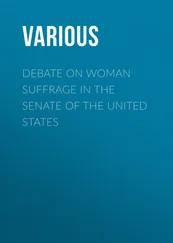But this pavilion rendered one good service to woman in showing her capabilities as an engineer. The boiler which furnished the force for running its work was under the management of a young Canadian girl, Miss Alison, who from a child loved machinery, spending much time in the large saw and grist mills of her father, run by engines of two- and three-hundred horse-power, which she sometimes managed for amusement. When her name was proposed for running the pavilion machinery it brought much opposition. It was said the committee would some day find the pavilion blown to atoms; that the woman engineer would spend her time reading novels, instead of watching the steam gauge; that the idea was impracticable and should not be thought of. But Miss Alison soon proved her own capabilities and the falseness of these prophecies by taking her place in the engine-room and managing its workings with the ease that a child spins a top. Six power looms on which women wove carpets, webbing, silks, etc., were run by this engine. At a later period the printing of The New Century for Women , a paper published by the centennial commission in the woman's building, was also done by its means. Miss Alison declared the work to be more cleanly, more pleasant, and infinitely less fatiguing than cooking over a kitchen stove. "Since I have been compelled to earn my own livelihood," she said, "I have never been engaged in work I liked so well. Teaching school is much harder, and one is not paid as well." She expressed confidence in her ability to manage the engine of an ocean steamer, and said there were thousands of small engines in use in various parts of the country, and no reason existed why women should not be employed to manage them—following the profession of engineer as a regular business—an engine requiring far less attention than is given by a nurse-maid or mother to a child.
But to have made the woman's pavilion grandly historic, upon its walls should have been hung the yearly protest of Harriet K. Hunt against taxation without representation; the legal papers served upon the Smith sisters when their Alderny cows were seized and sold for their refusal to pay taxes while unrepresented; the papers held by the city of Worcester for the forced sale of the house and lands of Abby Kelly Foster, the veteran abolitionist, because she refused to pay taxes, giving the same reason our ancestors gave when they resisted taxation; a model of Bunker Hill monument, its foundation laid by Lafayette in 1825, but which remained unfinished nearly twenty years until the famous French danseuse Fanny Ellsler, gave the proceeds of an exhibition for that purpose. With these should have been exhibited framed copies of all the laws bearing unjustly upon woman—those which rob her of her name, her earnings, her property, her children, her person; also, the legal papers in the case of Susan B. Anthony, who was tried and fined for seeking to give consent to the laws which governed her; and the decision of Mr. Justice Miller (Chief-Justice Chase dissenting) in the case of Myra Bradwell, denying national protection for woman's civil rights; and the later decision of Chief-Justice Waite of the Supreme Court against Virginia L. Minor, denying to women national protection for their political rights, decisions in favor of state-rights which imperil the liberties not only of all women, but of every white man in the nation.
Woman's most fitting contributions to the centennial exposition would have been these protests, laws and decisions which show her political slavery. But all this was left for rooms outside of the centennial grounds, upon Chestnut street, where the National Woman Suffrage Association hoisted its flag, made its protests, and wrote the Declaration of Rights of the Women of the United States.
To many thoughtful people it seemed captious and unreasonable for women to complain of injustice in this free land, amidst such universal rejoicings. When the majority of women are seemingly happy, it is natural to suppose that the discontent of the minority is the result of their unfortunate individual idiosyncrasies, and not of adverse influences in their established conditions.
But the history of the world shows that the vast majority in every generation passively accept the conditions into which they are born, while those who demand larger liberties are ever a small, ostracised minority whose claims are ridiculed and ignored. From our stand-point we honor the Chinese women who claim the right to their feet and powers of locomotion, the Hindoo widows who refuse to ascend the funeral pyre of their husbands, the Turkish women who throw off their masks and veils and leave the harem, the Mormon women who abjure their faith and demand monogamic relations; why not equally honor the intelligent minority of American women who protest against the artificial disabilities by which their freedom is limited and their development arrested? That only a few under any circumstances protest against the injustice of long established laws and customs does not disprove the fact of the oppressions, while the satisfaction of the many, if real, only proves their apathy and deeper degradation. That a majority of the women of the United States accept without protest the disabilities that grow out of their disfranchisement, is simply an evidence of their ignorance and cowardice, while the minority who demand a higher political status clearly prove their superior intelligence and wisdom.
[1] Some suggested that the women in their various towns and cities, draped in black, should march in solemn procession, bells slowly tolling, bearing banners with the inscriptions: "Taxation without representation is tyranny," "No just government can be formed without the consent of the governed," "They who have no voice in the laws and rulers are in a condition of slavery."
Others suggested that instead of women wearing crape during the centennial glorification, the men should sit down in sackcloth and ashes, in humiliation of spirit, as those who repented in olden times were wont to do. The best centennial celebration, said they, for the men of the United States, the one to cover them with glory, would be to extend to the women of the nation all the rights, privileges and immunities that they themselves enjoy.
Others proposed that women should monopolize the day, have their own celebrations, read their own declarations and protests demanding justice, liberty and equality. The latter suggestion was extensively adopted, and the Fourth of July, 1876, was remarkable for the large number of women who were "the orators of the day" in their respective localities.
[2] Letters were read from the Hon. Alexander H. Stephens, of Georgia; William J. Fowler, of Rochester, N. Y.; Isabella Beecher Hooker, of Connecticut, and Susan B. Anthony.
[3] News of the cannonade of Boston had been received the day previous.
[4] Though thus discourteously refused to an association to secure equality of rights for women, it was subsequently rented to "The International Peace Association."
[5] President—Elizabeth Cady Stanton, Tenafly, New Jersey.
Vice-Presidents —Lucretia Mott, Pa.; Ernestine L. Rose, England; Paulina Wright Davis, R. I.; Clarina I. H. Nichols, Cal.; Amelia Bloomer, Iowa; Mathilde Franceska Anneke, Wis.; Virginia L. Minor, Mo.; Catharine A. F. Stebbins, Mich.; Julia and Abby Smith, Conn.; Abby P. Ela, N. H.; Mrs. W. H. H. Murray, Mass.; Ann T. Greely, Me.; Eliza D. Stewart, Ohio; Mary Hamilton Williams, Ind.; Elizabeth Boynton Harbert, Ill.; Sarah Burger Stearns, Minn.; Ada W. Lucas, Neb.; Helen E. Starrett, Kan.; Ann L. Quinby, Ky.; Elizabeth Avery Meriwether, Tenn.; Mrs. L. C. Locke, Texas; Emily P. Collins, La.; Mary J. Spaulding, Ga.; Mrs. P. Holmes, Drake, Ala.; Flora M. Wright, Fla.; Frances Annie Pillsbury, S. C.; Cynthia Anthony, N. C.; Carrie F. Putnam, Va.; Anna Ella Carroll, Md.; Abigail Scott Duniway, Oregon; Hannah H. Clapp, Nevada; Dr. Alida C. Avery, Col.; Mary Olney Brown, Wash. Ter.; Esther A. Morris, Wyoming Ter.; Annie Godbe, Utah.
Читать дальше












